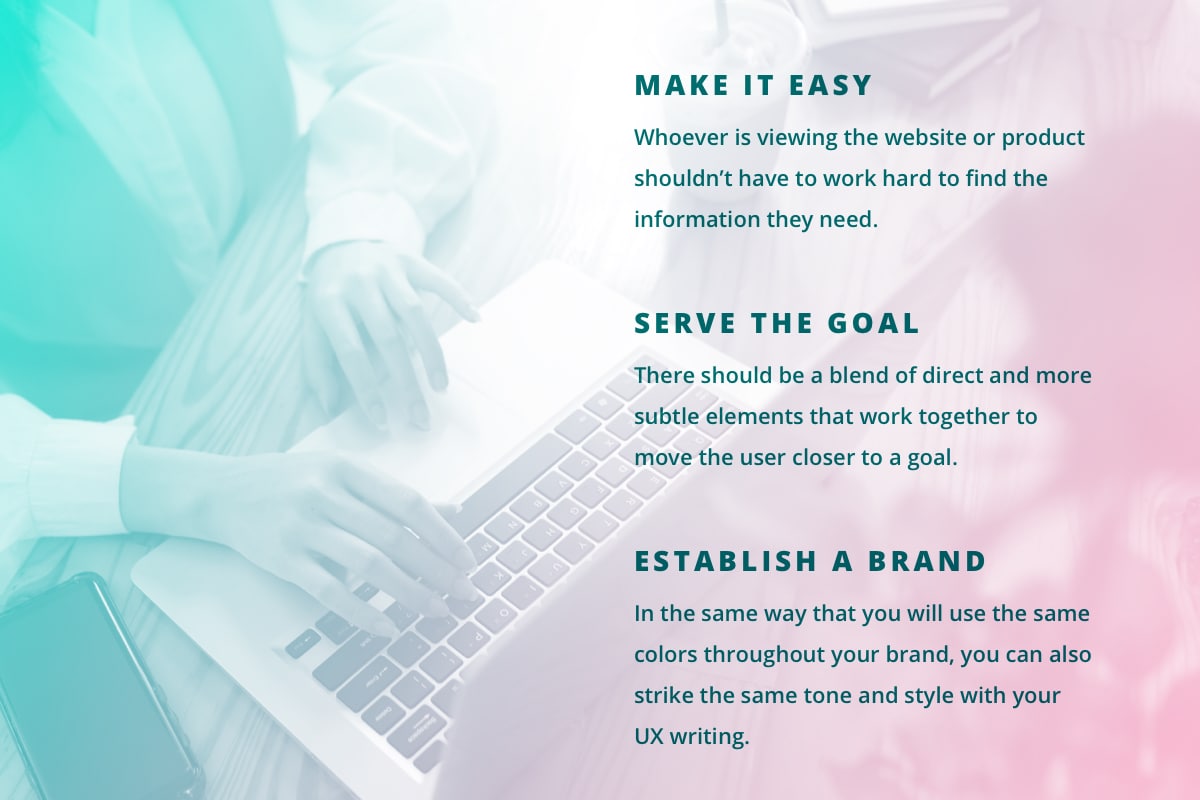
When discussing website design, “UX” is shorthand for user experience. For a UX designer, the task at hand is to enhance the experience that a user has with a product or service. This is often thought about in terms of websites and other digital assets like apps, but it certainly extends into the physical world, as well. The job of UX design is done well when the user doesn’t even notice it or think about it – the design just works. The overall performance and the experience of using a product or service are elevated as a result.
While UX design is a relatively well-known task, and the position of UX designer is one that is filled in many organizations, UX writing doesn’t have the same prominence. In this article, we’d like to talk about what UX writing is, and why it is just as important as the larger category of UX design in terms of delivering an excellent product or service to customers.
If you have never before given any careful thought to the words that are guiding your users around, that part of your business might take on a new sense of importance after reading the rest of this page. Let’s get started!
What is UX Writing?
Writing is all about delivering a message to an audience. Whatever type of writing it is, the goal is to deliver information and ideas in a way that accomplishes a specific goal. Of course, the goal that you have in mind for your writing can vary wildly from one project to the next.
For example, someone who is writing poetry may be trying to evoke a particular emotion within the reader or cause them to think about something from a new perspective. By contrast, someone writing an instructional manual for a product isn’t aiming to provoke thought or bring out emotions – they just want to get the point across as clearly as possible.
It’s against this backdrop of varied types of writing that we can understand what UX writing is all about. The task of UX writing comes down to using words to improve the way that customers interact with an interface. That interface could be a number of different things, but you’ll often see UX writing referenced in regard to websites. The words that are used on buttons, in menus, on forms, and for any other interactive items all play a role in the user experience. Carefully picking the right words to place in those important locations can help users enjoy their time on the website while at the same time furthering the company’s objectives by moving the users in a desirable direction.

Sometimes, you may see UX writing referred to as “microcopy”, which is an apt description of what it looks like in practice. There are usually only a few words in any one component – or maybe just a single word – but picking out those words can take time, experience, and testing to get right. The right word could cause someone to stay longer than they would have otherwise, or make a purchase when they might have decided to pass. Given the power that words have and the influence that good UX writing can have on the performance of websites and products, this is an area that is worth the investment of time required to get it right.
Understanding Key Theories
In a moment, we will highlight some keys to good UX writing that you can use to work on this skill and guide your decisions in this area. For now, however, we’d like to look at this topic with a wider lens to gain an understanding of what goals UX writers usually have in mind when doing their work. By understanding what it is you are trying to accomplish when doing UX writing, you can more easily make the small decisions word-by-word as you put together copy.
So, as a starting point, keep these three core theories in mind as they relate to UX writing.
- Make it easy. One of the primary objectives for a UX writer is to make the experience of reading as easy as possible for the user. Whoever is viewing the website or product shouldn’t have to work hard to find the information they need. That information should be available at a glance, and they shouldn’t really even notice that they are reading. When done correctly, the right information simply jumps out and is a natural part of the page. In some ways, good UX writing should go unnoticed, as it just plays its role without feeling forced or out of place.
- Serve the goal. There should always be a goal behind UX writing, and the words that are selected should serve that mission in some way. For example, if you are writing UX for a sales page, the goal is obvious – you are trying to turn as many visitors into customers as possible. So, everything that is written should help to move the user closer and closer to a purchase. That doesn’t mean that every element should just scream “BUY NOW!”, but instead there should be a blend of direct and more subtle elements that work together to promote what is being sold.
- Establish a brand. Another key element to UX writing is building a brand that you can lean on throughout your marketing process. You always want to have continuity in your brand from one place to the next, and UX writing can play a role in accomplishing that goal. In the same way that you will use the same colors throughout your brand to build trust and recognition among your audience, you can also strike the same tone and style with your UX writing to allow people to get familiar with your brand and what it offers. This might seem like a small thing, but it’s the accumulation of small things that leads more and more customers to engage with your business and come back time after time.

Some UX Writing Keys
With the theoretical background out of the way, let’s now shift our attention toward applying these concepts in the real world. The list below touches on some of the fundamentals of good UX writing. As you read, you will notice that these points play nicely into the points from above, as they should all serve at least one of our three core theories in one way or another.
- No walls of text. This is critical on the web, and there is a good chance you’ve heard this tip before. When writing with user experience in mind, don’t present your users with a big wall of text that is going to be hard to read. That comes back to our first point from above about making things as easy as possible for your target audience. There is nothing easy about a wall of text, so the user will likely just skip over it or leave the site entirely.
- Write with the audience in mind. Sometimes, businesses fall into the trap of using too much jargon or insider talk on their websites and even on their products. That can be okay in a B2B application where the reader is likely familiar with the terms you are using, but it’s troublesome in a B2C setting. Do your best to use plain, obvious language that doesn’t leave any room for confusion.
- Make it obvious. At first, it might seem like you are being accommodating by writing text that gives your users plenty of options. On a single page, you might use words that point them in several different directions – and who doesn’t like to have choices? The problem is that choices lead to indecision, and indecision leads to inaction. You want your customers to act, so don’t overload them with options. Just get right to the point about what action you want them to take. They won’t all take that action, of course, but your conversion rate will be much higher when you are intentional with what you ask them to do.
- Include personality. It’s easy enough for UX writing to come out bland and dry. Unfortunately, that will make your content pretty forgettable, and you certainly don’t want your brand to be forgotten. So, don’t be afraid to establish a distinct personality with your writing, and then do your best to maintain that personality moving forward. If multiple people are going to be working on these writing projects, consider establishing a style guide that outlines the personality of your brand and how the writing should be approached. There are plenty of options here, including a friendly tone, a confident and authoritative tone, or even a funny/sarcastic approach.
As with everything else in business, and in life, you’ll get better at UX writing with practice. In time, the voice of your brand will start to become clear, and you’ll be able to quickly produce the microcopy needed to get results. Of course, if you don’t have time to take this on, or the interest in doing it yourself, hiring a dedicated UX writer could be a good option.
Other Tasks for UX Writers
Doing the job of writing small chunks of copy that will be placed on websites or products is an obvious starting point for the work that a UX writer does. Rarely, however, is that the end of the story. There are plenty of other tasks that can be tackled by someone who specializes in this area.
As mentioned above, creating a style guide is an important step for many brands, and that’s a job that could be headed by an experienced UX writer. Also, the writer could create documents that go along with their copy to explain to the design team how the copy should be implemented and what they have envisioned for the writing. Further tasks that can be turned over to this person might include doing a content audit on a website, working with other departments or team members to complete projects, and doing research on the target user for a website.

UX writing is one of those things that is easy to overlook until you start paying attention – and then you can see the value of it just about everywhere. Now that we’ve gone over what UX writing is and why it matters, you may want to spend some time thinking about how to apply this valuable skill to the things you present to your customers. Whether you decide to hire a dedicated UX writer to work on these tasks, or you decide to train someone within your organization currently to be able to handle this duty, giving UX writing the attention it deserves is worth the time and effort.
Most Popular Articles

Seeing Favicons in Your Google Search Results? Here’s Why…
Have you noticed anything different in your Google Search results lately? Google added tiny favicon icons to its organic search results in January. It was…

Business Growth and Digital Marketing News & Tips 11-17-24
Are you encouraging and rewarding innovation? Lee Cockerell is the former Executive Vice President of Operations at Walt Disney World. A lover of traditional red…

Business Growth and Digital Marketing News & Tips 11-27-24
A culture of gratitude "Feeling gratitude and not expressing it is like wrapping a present and not giving it." – William Arthur Ward Beyond being…








